OF COURSE IT’S A DELI. If Family Feud asked “Name a deli in Chicago,” it would ring in as the number one answer. Nevertheless, by a strict definition of the term, Manny’s—which billed itself, much more accurately, as a coffee shop for many years—is not a deli. It’s a cafeteria serving Jewish deli food, and has been since the 1940s, but if you can’t buy by the pound, it’s not a delicatessen.
For a couple of more months, anyway. By year’s end, they hope to turn an empty space at the end of the Manny’s building into a deli counter for selling traditional Jewish foods to Chicagoans, and especially the residents of the neighborhoods that have been revitalized all around Manny’s, half a dozen blocks south of the Loop. And that’s just step one in a plan designed to keep this old-fashioned institution from following most of its competitors into existing only in the memories of aging customers. Manny’s story is a story about a traditional business trying to change with the times—and a business changing with the times by embracing the tradition it comes out of.
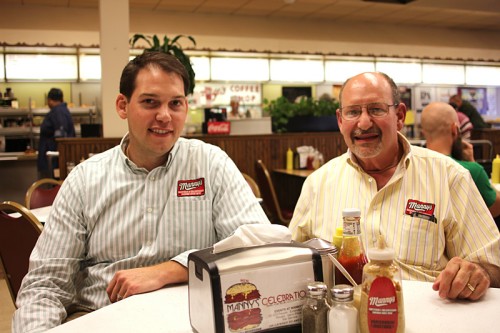
Dan and Ken Raskin
I’M SITTING WITH KEN RASKIN AND HIS SON DAN as a parade of humanity—there seems no better way to describe the size and variety of the crowd at Manny’s—passes through the line around 12:45 on a Tuesday. Ken and Dan are the third and fourth generation, though Manny wasn’t the first generation—the restaurant was started by Jack Raskin, who started a cafeteria in Greektown with his brother in 1942. He split off around 1947 to open one in what was then the Jewish neighborhood around Maxwell Street, and named it for his son Emanuel. The story is that the restaurant that had closed in that space was called Sunny’s, and Jack decided that the cheapest way to change the signage would be to replace two letters and call it Manny’s. (That one might be too good to check.) In time Manny inherited it, but he died in 1983 and passed it to his son Ken. And now Ken is working with Dan, the only one of his four children who actually wanted to make a life slinging deli, who’s about the age that Ken was when he took over Manny’s.
Though the first thing most people think of with deli food is sandwiches these days, Manny’s stands apart in that it still puts out a full daily spread of steam table Jewish comfort food entrees. The signboards behind the line seem like a museum of old-fashioned foods that haven’t changed since 1942—chopped liver, Salisbury steak, roast tongue. In fact, Manny’s offerings have evolved over the years—but glacially. “Some of the hot items that were very ethnic have disappeared—things like stuffed veal breast, herring or kippers, fried bologna and butter beans,” says Ken. “And they were great items!”
As the old Jewish neighborhood around Roosevelt faded, Manny’s gradually became a special occasion place—a stop on a visit to the city for suburbanites, a lunchtime splurge after a win at the office. Today, Ken says the audience for the hot items is definitely an older crowd; for younger and special occasion visitors, the attraction is what he calls “the fix”—corned beef and pastrami. “Usually they come here their first time and they get corned beef and pastrami. That’s it,” says Dan.
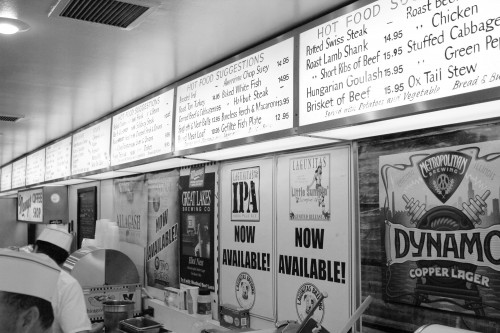
The problem with a business built on corned beef and pastrami sandwiches is simply that the price of brisket—the cut of beef both are made from—has shot up in recent years. Knowing his clientele will notice the slightest change in quality or quantity, Ken says “We’re stuck with big portions, and our food cost runs so high. How much can you charge for lunch?”
For Dan the question was, if your most popular food items are squeezing you, where else in the business can you squeeze out more profit in return? You can see one answer in the craft beer posters that run behind the line now, but beer isn’t going to save a place whose business is built on lunch. “One of the big things in our family is, when we go on vacation, we always try other delis across the country,” Dan says. “We like to get ideas from how other people are doing things. And that was the one thing I saw, everyone had a deli counter. They always had the carry-out component. Even in the delis in the north shore, they all have big delis and they do a lot of business out of them. We were the only well-known deli that didn’t have a deli component!”
Ironically, this was already after Manny’s-branded deli meats had been for sale for years—at places like Costco. Some years ago they switched from Vienna Beef to another local processor to make their corned beef—in part because Vienna was following the industry in favoring leaner corned beef, but as Dan says, the problem is that lean corned beef dries out quickly. (You can ask for lean corned beef at Manny’s, but you might get a look of pity.) So that product was picked up by wholesalers like Sysco and U.S. Foods as a premium brand with a history of authenticity, though Dan notes that its strongest market isn’t Chicago—it’s more likely to be small towns in Wisconsin or Minnesota where, apparently, they dream of Chicago deli.
In any case, the signs were there to finally make the deli a deli. “I knew we could do it. I guess I had to work for a while, and get my dad to trust me that I could actually do something else besides this part of the business,” Dan says, waving to the busy dining room all around us.
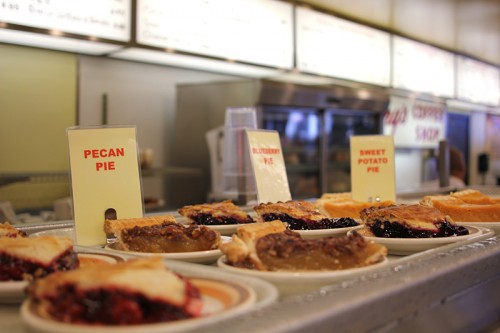
DAN LEADS ME OUT THE EXIT AND TO A PADLOCKED space at the back of the building. He opens the door, revealing a tiny construction zone of jagged concrete that seems incongruous sharing space with bustling Manny’s. Following the gaps outlined in the concrete, I can see where the deli counters will stand; you’ll be able to access this area either from the outside, like we just did, or from the dining room, while his father, presciently, had connected the kitchen to this space by a corridor even when the plan was always to rent it out.
There will be Manny’s branded corned beef and pastrami, the same product they serve in the restaurant. There will be prepared foods similar to what’s on the cafeteria line. There will be bagels (made and par-baked by New York Bagel and Bialy and finished fresh on site), and other baked goods—decorated cookies are a growth area for the business (think grandparents and grandchildren on Saturday afternoon). And—this starts to actually verge into the realm of healthier foods—they’ll have traditional Jewish seafood items, like smoked sable and whitefish, an area of deli food that’s been pretty absent from the city over the years.
There’s something else about the deli space that Dan acknowledges: if they can build one of them, they can build more. Manny’s as a restaurant is one of a kind—the only attempts at anything like more Mannys are at each of the Chicago airports—but the deli section could be reproduced anywhere in the area there’s a market for vintage deli food. Add a few cafe tables, and… it won’t be Manny’s, but it can be a Manny’s, anywhere.
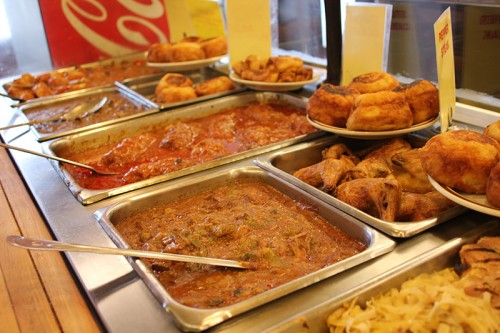
The restaurant will get some modernization at the same time. The infrastructure of the cafeteria line, like so many things in Chicago, is dated (to the opening of this building 50 years ago) and near the end of its life. The new line will extend further, and shrink the hot foods area with smaller pans of the same items, so that the line will actually begin with cold foods like salads. That may seem like a woeful misreading of what people go to Manny’s for—almost as if Ken, who’s lost 30 pounds recently, was proselytizing for veggies against what Manny’s stands for—but his logic is actually simple: “The thing is, people come in groups, and two or three people might not eat [deli]. We don’t want to lose a group because we don’t have those options.”
It also gives the seafood items a prime spot—where in Ken’s eyes, they help mitigate any fears that the other changes might provoke about Manny’s weakening its Jewish identity. “I think carrying the sable and the sturgeon, and putting some of these more ethnic foods out there, I think that’ll help preserve our image a little bit,” Ken says.
One last archaic aspect of Manny’s that’s going to bite the dust—the system where you get a ticket once you’ve picked out your food, but pay at the door after you eat (if you can find your ticket). “We did that because of how slow handling credit cards was back in the day. One person would hold up the whole line for two or three minutes,” Dan explains. They’ve invented computers to speed that up since Manny’s opened here in 1965, so at long last, you’ll just pay and sit down like any other self-service restaurant in 2015. Hey, some change is good, even at Manny’s.
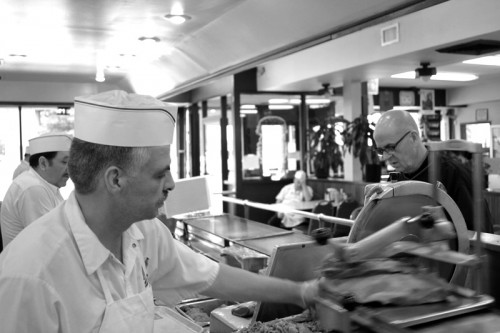
“THE CUSTOMERS HAVE CHANGED tremendously,” Ken says. “Years ago, there were a lot of small merchants and manufacturers in this area, so we were their go-to place. People came, the old-timers—they weren’t old then—they wanted to beat the traffic, so they came in at 4:30, 5:00 in the morning. So they had breakfast and spent two hours here, kibitzing between the tables. You had the scrap guys, you had the Organized Crime police unit and the First Ward guys sitting across from them… a really interesting mix.”
“These people came back for lunch, every day. Some of them came back for dinner,” he continues. “All those people are gone. They might, if they’re still alive, come back for a special occasion. But the newer customer—first of all, breakfast during the week isn’t important. It’s grab and go.”
In some ways the wonder isn’t that Manny’s is still going in 2015—it’s that it survived to 1975. The urban unrest of the 1960s in Chicago drove so many Jewish businesses and residents to the suburbs—the Raskins, by the way, live in Skokie—and we’re just a couple of blocks from where UIC and the Circle Interchange wiped out equally thriving Greek and Italian neighborhoods on the near South Side. Manny himself could easily have been the last member of the family to operate Manny’s, and it could have gone into the memories of old Jewish Chicago, like Nate’s or Thorndale Deli or the Strulevitz Tea House.
“That’s the key to being able to work in the family business, that you can’t hold onto the same problem. It’s not corporate America.”
The other threat that delis face is generational. You work hard so your kids can become doctors or lawyers, and then there’s no one left to sling corned beef. And as David Sax’s great book Save the Deli points out, delis tend to survive when they stay within a family, and tend to decline when they don’t:
When you have children, parents and grandparents all putting in their two cents, the compromises that emerge ultimately leave stronger delis in their wake. On the other hand, delicatessens that were sold outside the family were always discussed in terms of sadness. “Oh them,” someone in the business would say. “Yeah, it’s a shame. It used to be such a great place, but it’s changed hands so many times.”
Even with four kids, there was no guarantee that Ken Raskin would have a successor in the family. All of them have worked there, and Dan talks about the help he gets from his siblings with technology or marketing, but he’s the one who’s in the trenches every day with the kishkes and the prune tzimmes.
But Manny’s is a family place and maybe it’s unimaginable that somebody in the family wouldn’t carry that on. “I always wanted to work here,” Dan says. “I think I didn’t realize how hard, at times, some of the things were. I have the mentality that there’s times that it’s hard, and there’s times that I definitely don’t want to be here, especially working with the family—but I’m able to get over it pretty fast. That’s the key to being able to work in the family business, that you can’t hold onto the same problem. You’ve just got to move on to the next thing. It’s not corporate America.”
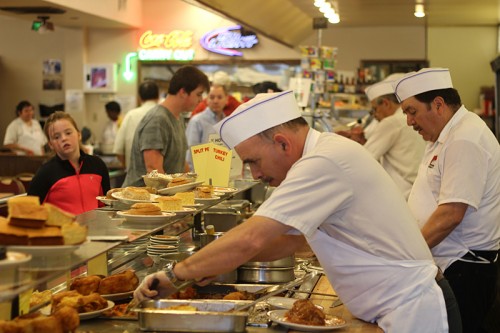
And this is why the sustainability of delis matters now—it’s for families. Deli, which used to be the food of urban tough guys, machers and hustlers and Broadway Danny Rose types, is a nostalgia act that conjures up that lost world. So Manny’s is changing to be even more of itself. “I think Chicago’s becoming more family friendly, and people associate deli with family,” Dan says. “If you ask any customer, they talk about how their dad took them here and they would come here all the time when they were a little kid. It’s so nostalgic for people as a family that I want to do everything we can to keep these families coming here together.”
Then there’s the employees. The word “family” gets thrown around a lot about them, too, but what else do you call it when, in an era where everyone complains about how hard it is to keep kitchen staff, employee longevity at Manny’s borders on the supernatural? The woman who cooks the hot foods has been there 32 years, and learned her recipes from the only other person to hold that job, ever. The breakfast cook has been there 35 years; Gino Gambarota, the twinkle-eyed corned beef man (getting ribbed by him over your order is a rite of passage for Manny’s customers), has been there at least as long. Somebody must be the new guy, with only a decade and a half, but I’m not sure who it would be.
All that family feeling was waiting for what’s finally happening in its neighborhood, and the city in general—families moving back into downtown and the South Loop and the near South Side, staying in the city with their kids, and turning to survivors like Manny’s for a taste of what life in the city was like in its rougher, more ethnically colorful days. “I would like to cut back,” Ken, who recently turned 60, says. “But this business, it’s a life. And luckily the woman I married has been putting up with it for almost forty years.” He turns to his son. “Your mom’s in the basement, baking the cookies. She really is.”
Michael Gebert is the editor and fresser-in-chief of Fooditor.
Latest
Join the Discussion
After you comment, click Post. If you're not already logged in you will be asked to log in or register with Disqus.






Great article Michael, couldn’t pass up being your first commentator. I grew up loving Manny’s as a suburbanite making quarterly visits with my dad, which we still do to this day. Everything they are planning sounds really smart, I just hope the new design isn’t too sleek, the ambience is almost as important as the food when it comes to nostalgia. And Gino… he definitely adds to the nostalgia and is for me the best part of going there.
There are few dining places about which one might say, “Chicago would be a lesser city without it.” Manny’s is one of those places. Just don’t order the smelts.
A great read, and now I know where I’ll be going for lunch this weekend. My great-grandfather owned a little grocery/butcher shop/bakery (he did the meat, my great-grandmother did the baking) with a loyal neighborhood following and stuff like this makes me wonder what could have become of their shop if it had survived.
[…] food experience” in full multimedia glory — words, pictures, audio and video. (First up is a delicious schmear on Manny’s.) A James Beard Award winner and former Grub Street Chicago editor who also wrote for […]
[…] It’s not a deli until it sells meat by the pound. And that’s the legendary Chicago restaurant’s strategy for the future. Fooditor breaks the news. […]
[…] It’s not a deli until it sells meat by the pound. And that’s the legendary Chicago restaurant’s strategy for the future. Fooditor breaks the news. […]
[…] There is a deli meat until it is offered by the pound. And that is the technique of the legendary Chicago restaurant for the long term. Fooditor breaks the information. […]
[…] MORE SUBSTANTIVE CONTENT THAN THIS in the future (beginning with my Manny’s profile today), but indulge me in one post by way of saying thanks to Chicago’s chef/food […]
It will be the site of my last meal on Earth if I can work that out. It is (for this relocated Chicagoan and now Minnesota boy) the BEST joint on the planet.
I’ll be there Saturday for lunch. Get the pastrami ready.